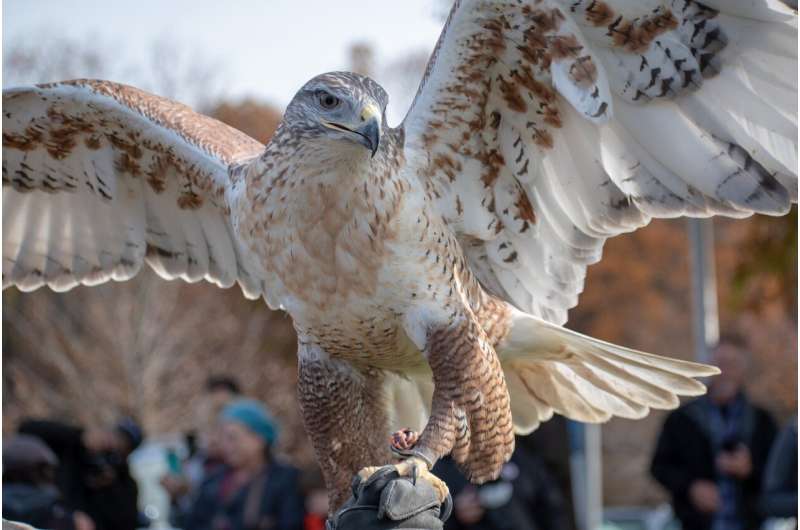
What began as the largest wind project ever proposed in Washington—the Horse Heaven Hills wind farm—will likely soon be cut to a fraction of the original vision.
Why?
Because more than 100 of the turbines, which could stand taller than the Space Needle, might pose a danger to a little-known and endangered species in the Tri-Cities area: the ferruginous hawk.
To protect the hawk, Washington's Energy Facility Site Evaluation Council, or EFSEC, will consider removing more than half of the project's proposed turbines, marking a victory for ecologists who petitioned for the changes but a substantial defeat for the Colorado developer behind the project and a delay for this state's renewable energy goals.
The council, which serves as a clearinghouse for regulatory and permitting hurdles these types of large projects face, asked its staff late last month to draft a recommendation that would remove any turbines too close to any hawk's nests. It's expected to vote whether to finalize that decision in the coming days or weeks.
The potential cuts underscore the difficulties developers face in finding the right location for the kinds of massive renewable energy projects Washington needs to wean its grid off fossil fuels and to meet the ever-increasing demand for the power.
"It's just too risky to invest in Washington," said Michael Rucker, founder and CEO of the project's developer, Scout Clean Energy.
On the other hand, even if halved, the wind farm would still be Washington's second-largest. The Windy Point project in Klickitat County would continue to hold the first-place spot. And environmental advocates say the anticipated decision shows the state can protect its natural habitat and build more clean energy at the same time.
The original proposal from 2021 would cost $1.7 billion and include up to 222 wind turbines across 24 miles of the Horse Heaven Hills near the Tri-Cities. In addition, three solar arrays would cover up to 5,447 acres in the area.
The wind farm marks the most ambitious step in recent years toward Washington's renewable energy and emission-cutting goals. Even so, if fully built, the project would add less than 5% of the total clean-energy capacity the state needs by 2035. And now EFSEC appears ready to cut that capacity in half.
Opposition to the project arose almost immediately, similar to that seen by the Nine Canyon Wind Farm, which was built in the area decades earlier. This time the most vocal pushback comes from a small group of local retirees called Tri-Cities C.A.R.E.S., arguing the new turbines would sit too close to the community, scarring their scenic views and lowering property values.
The group also seized on the threat to endangered species.
The ferruginous hawk
With a wingspan of up to 56 inches, the ferruginous hawk is North America's largest buteo, a type of medium to large, wide-ranging raptor.
Early historical records indicate the species was once "relatively abundant" in the state (mostly in Eastern Washington), according to a 2021 report from the state Department of Fish and Wildlife.
Over the past 50 years as farms and cities expanded, the hawk's habitat shrank, and by the early to mid-'90s, an average of 55 breeding pairs nested in the state, the report found. Since then the numbers declined further and habitat conditions have only grown worse.
More than 200 nests are known to exist throughout 12 Washington counties, with the majority sitting in Franklin and Benton counties, the report says. The hawks build their nests on rocky outcrops and the ground. If those nests are close to turbines they're at an increased risk of being killed by the fast-spinning blades.
The hawk had been listed as "threatened" by the department since 1983, but after a routine review in 2021, which also generated the report, the species was pushed onto the "endangered" list, department spokesperson Jennifer Becar said.
Despite the state listing in Washington, the hawks enjoy no such protections at the national level. Federal officials considered the matter in 1983 and 1991 but found that a national listing was not warranted.
Eastern Washington could be considered the edge of the hawk's range, said Trina Bayard, interim executive director for the National Audubon Society's Washington office. Even so, the hawks have been known to return to empty nests decades after they left.
Bayard and biologists with the Department of Fish and Wildlife recommended that any turbines in the area should not sit within 2 miles of any ferruginous hawk nests.
2024 The Seattle Times. Distributed by Tribune Content Agency, LLC.
Citation: How an endangered hawk could topple plans for WA's largest wind farm (2024, February 22) retrieved 22 February 2024 from https://techxplore.com/news/2024-02-endangered-hawk-topple-wa-largest.html
This document is subject to copyright. Apart from any fair dealing for the purpose of private study or research, no part may be reproduced without the written permission. The content is provided for information purposes only.
